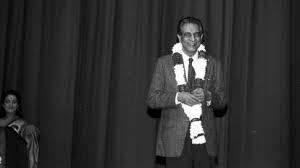Demolition of Satyajit Ray’s ancestral home in Bangladesh halted

In a welcome move for cultural enthusiasts and historians, the Bangladesh government has stopped the demolition of a house in Mymensingh. The property is widely believed to be linked to the family of Satyajit Ray, the iconic Indian filmmaker. The decision came after strong objections from both Indian and Bangladeshi cultural circles.
A Home with a Deep Cultural Link
This house once belonged to Upendrakishore Ray Chowdhury, Satyajit Ray’s grandfather. Upendrakishore was a noted writer, illustrator, and pioneer of Bengali printing. Though the family lived in several locations, this residence holds symbolic value. It connects the Ray family to Bangladesh’s rich cultural past.
Satyajit Ray, born and raised in Kolkata, came from a lineage that deeply influenced the Bengal Renaissance. His family’s legacy spans across the present-day India-Bangladesh border.
Demolition Sparks Uproar
Authorities in Mymensingh recently began tearing down the old house. Officials said it was unsafe and had remained unused for over a decade. The building had functioned as a Shishu Academy (children’s center) in the past but was not officially listed as a heritage site.
The demolition, however, drew sharp criticism. Cultural activists and local citizens expressed concern. Many felt that Bangladesh was losing a key part of its shared history with Bengal. The move triggered a public outcry on social media and in political circles.
India Steps In to Support Preservation
India’s Ministry of External Affairs responded quickly. The ministry expressed regret and urged Bangladesh to halt the demolition. India also offered support in preserving the structure. Officials suggested converting it into a museum or cultural center that honors the Ray family’s legacy.
West Bengal Chief Minister Mamata Banerjee added her voice to the matter. She wrote to the Bangladesh government, requesting them to protect the site. “This is not just a house; it represents Bengal’s creative spirit,” she said.
Bangladesh Government Pauses Demolition
Soon after these appeals, the Bangladesh Department of Archaeology stepped in. They instructed local authorities to stop all demolition work. A special committee will now inspect the building. Experts will assess if it can be restored or repurposed.
This action has eased tensions and brought hope to many heritage supporters. Citizens and cultural groups praised the quick response.
Debate Over the “True” Ancestral Home
The situation has also sparked debate over the exact location of Satyajit Ray’s ancestral home. Some historians say the actual home lies in Moshua village, Kishoreganj district. That site, linked to Ray’s great-grandfather Harikishore Ray, was restored earlier and is officially protected.
Still, many believe the Mymensingh home holds cultural value. It was part of the family’s story and served as an important stop in their journey. Experts argue that multiple homes can reflect a shared legacy, just as literary giants like Shakespeare are remembered across various locations.
A Cross-Border Cultural Duty
This incident highlights the importance of cross-border heritage efforts. India and Bangladesh share language, literature, music, and history. Satyajit Ray and his family are part of that shared cultural identity.
Preserving such sites is a joint responsibility. These structures help future generations understand and connect with the region’s artistic past. Historians emphasize the need for more collaboration between both countries on cultural preservation.
The Path Ahead
With the demolition paused, experts will soon visit the site. They’ll inspect the structure and recommend steps for restoration. Some groups have proposed turning it into a Ray Heritage Centre. This could include displays of old photographs, writings, and films that trace the Ray family’s legacy.
Local residents support this idea. They believe the center could bring educational value and attract visitors. Cultural groups in Mymensingh have already started awareness campaigns about the home’s significance.
Final Thoughts: Why Heritage Matters
Stopping the demolition of Satyajit Ray’s ancestral home sends a powerful message. It shows the growing awareness around protecting historical sites. These places offer more than just bricks and mortar—they offer stories, memories, and identity.
Figures like Ray don’t belong to one country. They belong to the world. By preserving places tied to their lives, we celebrate the creative spirit they left behind.






